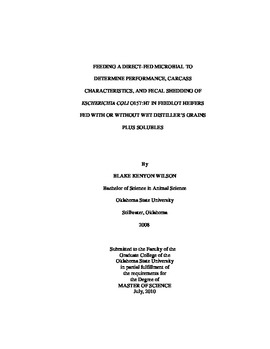| dc.contributor.author | Wilson, Blake Kenyon | |
| dc.date.accessioned | 2014-04-15T20:13:19Z | |
| dc.date.available | 2014-04-15T20:13:19Z | |
| dc.date.issued | 2010-07-01 | |
| dc.identifier.uri | https://hdl.handle.net/11244/8892 | |
| dc.description.abstract | Fluctuating corn prices related to increased ethanol production have had a significant impact on the cost of gain for cattle feeders that rely on corn-based diets. The inclusion of wet distiller's grains plus solubles (WDGS) in feedlot diets has become a common practice in many regions of the U.S. due to the expanded production of by-products. In addition, societal concerns over the continued use of antibiotics in production agriculture combined with an enhanced interest in disease and pathogen prevention in the food supply have led to an increased interest in use of direct-fed microbials (DFM) in growing and finishing cattle. Direct-fed microbials have been shown to improve ADG and feed efficiency, alter ruminal fermentation, and decrease fecal shedding of harmful pathogens in feedlot cattle. The objective of this experiment was to evaluate the effects of Lactobacillus acidophilus combined with Propionibacterium freudenreichii on performance, carcass characteristics, and Escherichia coli O157:H7 shedding in feedlot heifers fed with or without WDGS. Crossbred heifers (n = 288; initial BW = 295 28 kg) were assigned to 1 of 4 treatments (12 pens per treatment; 6 heifers per pen) in a randomized complete block design with a 2 2 factorial arrangement of treatments. Across the feeding period, heifers fed 30% WDGS tended (P = 0.09) to have greater ADG and had greater carcass-adjusted ADG (P = 0.05) compared with heifers fed dry-rolled corn (DRC). Dry matter intake was not affected (P = 0.65) by diet, although carcass adjusted G:F tended (P = 0.10) to be improved for heifers fed WDGS. Heifers fed 30% WDGS tended (P < 0.10) to have greater fat thickness at the 12th rib, lower marbling scores, and higher yield grades. The inclusion of L. acidophilus combined with P. freudenreichii in the diet had no effect (P > 0.10) on performance or carcass merit in the present experiment. The incidence of Escherichia coli O157:H7 throughout the experiment was low, with only 18 positive samples across all sampling periods. Neither WDGS inclusion nor the inclusion of L. acidophilus combined with P. freudenreichii in the diet had any effect (P > 0.10) on E. coli O157:H7 shedding in this experiment. Feeding 30% WDGS to feedlot heifers improved animal performance compared to the DRC based control diet. | |
| dc.format | application/pdf | |
| dc.language | en_US | |
| dc.publisher | Oklahoma State University | |
| dc.rights | Copyright is held by the author who has granted the Oklahoma State University Library the non-exclusive right to share this material in its institutional repository. Contact Digital Library Services at lib-dls@okstate.edu or 405-744-9161 for the permission policy on the use, reproduction or distribution of this material. | |
| dc.title | Feeding a Direct-Fed Microbial To Determine Performance, Carcass Characteristics, and Fecal Shedding of Escherichia Coli O157:H7 in Feedlot Heifers Fed With or Without Wet DistillerS Grains Plus Solubles | |
| dc.type | text | |
| osu.filename | Wilson_okstate_0664M_11018.pdf | |
| osu.college | Agricultural Sciences and Natural Resources | |
| osu.accesstype | Open Access | |
| dc.description.department | Department of Animal Science | |
| dc.type.genre | Thesis | |
| dc.subject.keywords | beef cattle | |
| dc.subject.keywords | direct-fed microbial | |
| dc.subject.keywords | distillers grains | |
| dc.subject.keywords | lactobacillus acidophilus | |
| dc.subject.keywords | propionibacterium freudenreichii | |
| dc.subject.keywords | wet distiller's grains plus solubles | |
